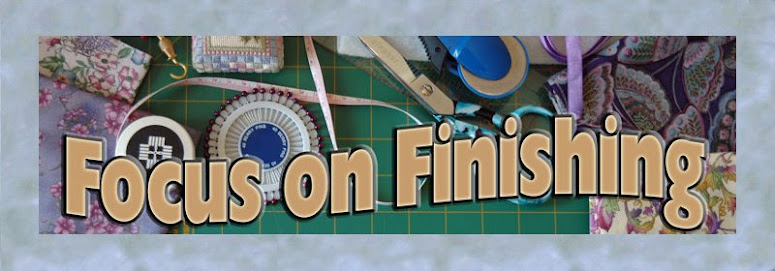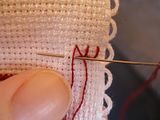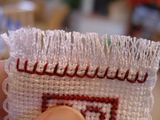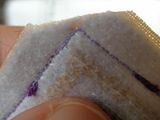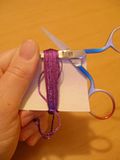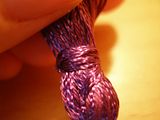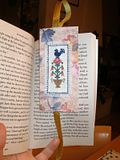Bookmarks don't get enough credit, IMHO. They're a great way to show off and use a small design, they're a quick and personal gift for a friend, and they're a chance for even the most fumble-fingered finisher to express her (or his!) creativity. In this weekend's tutorial, I'm going to show you how to make three kinds of bookmarks - but don't let yourself be hemmed in by my suggestions! Your imagination is your only limitation. :)
All the pictures can be clicked for a larger, clearer image.the standard band bookmark
We've all seen them, we probably even have one or two of our own - a bookmark stitched on linen or Aida banding. The pre-made banding makes it incredibly easy to whip off a bookmark in an afternoon. Using scraps of linen can not only put you on your way to a tiny work of art, but can also help you make the most frugal use of those expensive hand-dyed and over-dyed linens. All you need to know is the simple hemstitch, and I'll provide some pictures that will show you what child's play this is. For this tutorial, I've used ready-made banding with hem stitching on the ends.
Select a pattern, or portion of a larger pattern, that fits on the fabric you'll be using. If you need it, a handy stitches-to-inches converter can be found
here. Stitch your design, exercising some care to center it on the long sides (where the band is closed) and to leave enough room to work comfortably on the short sides. Once you've stitched your pattern, it's time to secure the fabric so the bookmark can be used without it unraveling. I'll show you how to do this using a hemstitch. Some people prefer to sew a backing to their bookmark or iron on interfacing, which secures the fabric and also hides the backside of your stitching, but I think this is unnecessary and can make the bookmark too thick. Just keep the back of your stitching neat. ;)
the hemstitch, demystified
I have hemstitched two-over-two. I've railroaded my stitching to keep it tidy. To begin, bring your needle up two holes further
away from where you want the solid line of the hemstitch to be, as shown int the
first photo. (Note that the 'teeth' of the hemstitch point outwards from the stitched design, as shown in the
seventh photo.) For example, if you've decided to leave five stitches empty between your design and the hemstitch, you'd count out ten holes plus an additional two. On the front side of the fabric, bring your needle down two holes, slip it under the fabric and slip it back out to the front side two holes further along, as shown in the
second photo. Insert your needle where it is two holes under the spot you first came up through the fabric, slip the needle under the fabric and re-emerge two holes to the side of where you initially came up through the fabric, as shown in the
third photo. And from here on, you simply repeat the same motions until you reach the end. Watch your thread tail on the back side, adjusting it as necessary so it is held down by your stitches. When you reach the end of your row, finish with the thread on the back side and weave it under and over the stitches to secure it before cutting it, as shown in the
eighth photo. You can now cut your fabric, either cutting it at the ends of the hemstitch 'teeth' or leaving a few rows to unravel for a fringe.
the cushion bookmark with tassel
For this design, you'll need a small-ish, squarish design. I've used Hedwig's Four Patch, a freebie from
The Sampler Girl, which is 40 stitches square. I'm machine stitching mine, but you can obviously hand stitch instead. To keep everything straight, I've counted out and removed a thread along the stitch line (a handy tip I got from
Isabelle) and counted out and removed another thread for where I needed to cut the fabric.
I have a backing fabric of a similar size. Because pins make the fabric lumpy for such a small project, I've basted the backing fabric and the cross stitched fabric together using a bright purple thread along the pulled thread. This basting thread can easily be pulled or cut out after the machine stitching.
After the machine stitching, clip the corners before you turn the fabric right side out. This will prevent excessive bulkiness. After the cushion is turned right side out, lightly stuff it. A chop stick is great for getting stuffing into the corners. ;)
Before you can close your bookmark, you need to make a tassel and attach that to a ribbon. I've used a large bead to disguise the join between ribbon and tassel. Making a tassel is easy, you just need a form to wind the floss around. For my tassel, I've cut a piece of cardboard about two inches wide (along the winding edge). I'm using two different flosses in my tassel - get creative and try different colors, different textures, etc.! Before you begin winding, make sure you have a loose piece of floss in place. This will be used to tie the top of the tassel and eventually to form the 'neck' and 'head' of your tassel. Begin winding with the tail of your floss at the edge of the form opposite from this loose thread.


When you're finished winding floss over your form, end on the edge that's opposite the loose thread and cut this tail even with the form. Use the loose thread to tie the top of the tassel tight. Cut the bottom edge loose from the form. You will have something that resembles the final photo.
Now bring that loose thread down over the top of the tassel and begin winding it in a sort of band to create the neck of the tassel. When your neck is tight and you like how it looks, tie this loose end securely and clip it. Now you have a tassel - congratulations!
Next, you need to attach the tassel to the ribbon. The ribbon will be the part of the bookmark inside the book, so choose a length that will fit comfortably inside the average size book you read. Paperbacks will only require a fairly short length, whereas special editions, coffee table books, etc. will require a longer piece. If you are using a bead, string the ribbon through the bead before you attach it to the tassel. Run a loose thread through the head of the tassel, run a separate piece of loose thread through the ribbon, and use these loose threads to sew the ribbon and tassel together. Slide the bead over the join to disguise it.
Now you can slip the other end of the ribbon into the cushion opening and hand stitch everything closed. Voila, a very lovely bookmark that really is a work of art. :)
a magnetic bookmark using cardstock
And finally, a very practical bookmark that will keep your place even if you drop your book or if one of your kids 'helps' you by moving your book around. The magnets in this bookmark are more persistent than clumsy fingers or helpful kids. ;)
Here's what you'll need: two magnets, a length of ribbon, a small stitched design (mine's been hemstitched around the edges and I have ironed interfacing on the backside), two equal-sized pieces of cardstock, and clear-drying craft glue.
Apply glue to the ribbon where you want to mount the cardstock. I suggest making light marks on the ribbon to get the glue in the right places. ;) After the cardstock is glued to the ribbon, apply a generous layer of glue to the magnets and attach them to the ribbon, as shown. Make sure that you glue the magnets on so that the sides that 'like' each other are facing each other. Otherwise your bookmark will never close. LOL!
After the glue for the ribbon/cardstock/magnet arrangement has dried, apply a generous (though not thick) layer of glue to the backside of the stitched piece. This is why you need interfacing on the back side - otherwise, the glue will go right through to the stitching. I use a brush to keep the layer even and to get it right to the edges. Affix the stitched piece to the right side of the front piece of cardstock and let it dry.
Voila! A lovely, practical bookmark you can enjoy for years to come!
Tutor = BarbaraCL













